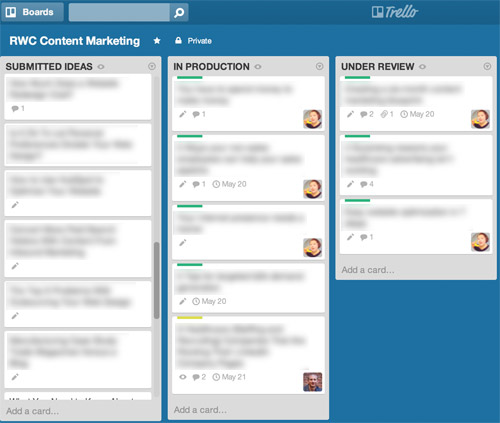A high-quality, frequently updated blog catches more than just the eye of Google. In fact, the purpose behind blogging on your company website is more than SEO.
Effective blogging campaigns attract prospective customers in the throes of researching their problems and possible solutions. The blog posts themselves provide valuable information and insight, and -- most important of all -- establish trust and credibility with your prospective clients.
Sounds good, right?
Unfortunately, it’s not enough to put “blog writing” on your weekly to-do list. To attract new clients, your blogging plan needs to be well-researched and thoughtfully executed. Here are five distinctive phases of a powerful six-month content marketing blueprint:
Summary 5 distinct phases of a proper content marketing blueprint
- Set clear, measurable goals.
- Identify relevant triggers.
- Brainstorm and develop content assets.
- Optimize each piece of content.
- Execute and promote.
What is a content marketing blueprint?
A content marketing blueprint is a strategic plan that outlines the goals, strategies, and tactics for creating and distributing relevant content to attract and engage a target audience. It serves as a roadmap for content creation and promotion, ensuring that every piece of content aligns with the overall marketing objectives.
Content plays a crucial role in digital marketing, serving various purposes and driving different outcomes.
- By providing valuable content that addresses their challenges, you can attract your ideal prospects as they actively seek solutions. Your content will appear in search engine results, making it easier for them to find the information they need.
- It fosters a sense of trust and establishes credibility among potential customers.
- It provides valuable educational resources and answers that are essential for your prospects to gain insight into their current situation.
- It serves as a medium to communicate your brand's unique value proposition and differentiate yourself from competitors.
- It acts as a valuable tool in the sales process, enabling sales representatives to establish meaningful connections with potential customers.
A thoughtful content plan is an investment in reaching your business goals, ultimately driving more visibility, leads, and revenue for your business.
Curious about how to create your own content marketing blueprint? Here are five simple steps to get you started.
1. Set clear, measurable goals.
Successful plans require clear, measurable goals. Not only will these goals inform changes to your strategy as you go, but you can monitor your progress to stay motivated along the way.
How will know that you’ve succeeded? What numbers will you be able to tie to your content marketing efforts? These are your performance metrics. Here are a few you might want to make note of:
- Organic, referral & social media visits
- Call to action (CTA) click-through rate
- New Leads generated
- Quality of lead generated
- Leads marked as “opportunities” by sales.
- Opportunities converted to customers
- Revenue
Create clear and measurable goals for the next six months and twelve months, as well as monthly or quarterly goals to track your progress along the way. Regularly assess your goals at the six-month mark to determine if any adjustments need to be made to your strategy.
How can you effectively define your goals?
At Whittington Consulting, we offer a C-level business analysis designed to determine a digital marketing plan that will generate a return on investment. We invite you to get more information using the link below.
2. Identify relevant triggers.
What causes your prospective customers to search for information online about your industry?
These are marketing triggers -- realizations that they need to do something or find out information about something. You can also do keyword research to find out what these triggers might be. After all, people don't sit down at a computer and Google things for no reason.
Brainstorm a list of these triggers -- as many as you can -- and write them down. You'll probably start to see a pattern emerge or see that several can be rolled up into a larger goal. When you start to slow down, turn to other strategies to identify relevant topics.
Use these topics as your keywords and as your topics for the content you plan to develop.
3. Brainstorm and develop content assets.
Once you have identified a set of marketing triggers, it’s time to turn it into clickable content.
Next, write down several questions your prospective customer asks you and group them under the corresponding trigger. These will be your blog topics.
Leveraging innovative AI tools such as ChatGPT presents an excellent opportunity to gather content ideas and uncover the questions and topics that pique your customers' interest.
You’ll want to blog at least once a week with well-written, 400-800 word blog posts that speak to your buyer’s questions and awareness.
Create an editorial calendar based on how often you need to update your blog and begin filling out topics.
There are several ways you can develop this calendar. You can base it by season, on your own product releases, or on popular events in your industry. Or you can build your calendar in monthly sets according to topic depth (increasingly more specific on a topic) or timeliness (increasingly more acute to an event).
4. Optimize each piece of content.
Optimization refers to the process of making your content more digestible to search engines. When you’re developing a content marketing blueprint, both the headline and the content itself needs to be optimized.
There's no rule that says you can't make your blog post's title the actual question your customer asks you.
If you're stuck, though, use tools like Hubspot’s Blog Topic Generator or Portent’s Title Maker to fill out titles for your editorial calendar. Or, create titles using a formula that is sure to interest your prospective audience.
Make sure that your marketing trigger keywords are included in both the title and the content of your blog post. If you mention your product or service, be sure to link people to it in the body of the blog post. Optimizing your content could take up a whole post, so start there.
One last tip on organizing thoughts as you write. We use Trello to organize topics. When we think of blog ideas, we write the post title in a "Submitted Ideas" bucket. Here, we can research the topics and make notes on them. When they are being written, they move into an "In Production" bucket, then in an "Under Review" bucket. We've found this helpful in blog post development because it gives us a central place to organize ideas.
Here's a screenshot from our own Trello board. Each topic is a "card" where we can comment on ideas and add research as we outline each blog post.

5. Execute and promote.
Once you’ve set deadlines and implemented your editorial calendar, zero in on promoting your content. On social media platforms, tag other people in your updates and use hashtags and topic tags, especially on Twitter and LinkedIn. Include recent blog posts and content releases in your company newsletter and use your personal network to get the word out.
For a twist, keep an eye out for other people’s social media, too. Set up social media monitoring for competitors and partners. If a certain topic in your industry gains popularity because of a recent news update, review your content assets and move your schedule around to catch the news cycle. To automate this process more, look into tools like SocialEars and Social Mention. We use HubSpot's social monitoring tool to monitor industry topics and news sources for clients. Aim to capitalize on trends whenever possible.
Developing an effective content marketing blueprint requires advanced planning, but the payoff might astonish you. Invest time and energy in these five phases to turn your target audience into happy customers.
Do you need help with content planning?
If all of this seems too daunting, we offer a service where we work with you to develop a content marketing blueprint for your business based on your ideal customer profiles. If you are having a hard time thinking of blog topics, or think that your industry is "too boring" to sustain a blog, we can develop this for you. Find out if it's right for you here.
This article was originally published on May 15, 2014, and last updated on November 9, 2023.
Share & Prove You Found It First
The Digital Slate
Looking for timely digital marketing and sales insights to grow your business? Subscribe to our monthly digital newsletter for marketing professionals.
Subscribe




